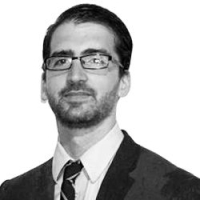
Sleeping in the Columbia University library. Love letters describing “bourgeois liberalism.” A yearlong relationship with a white woman. Vanity Fair published on Wednesday an excerpt from David Maraniss new biography of President Obama, titled Barack Obama: The Story and due to hit bookshelves on June 19. From the “unique” smell of Obama’s post-college apartment to his Pakistani friends, The Daily Beast finds the juiciest bits from the excerpt that shows the leader of the free world to be more Lena Dunham than Lyndon Johnson.
Sleeping in the library
When Obama first moved to New York in 1981 as a junior at Columbia, he lived in an apartment on West 109th Street. Since the heat didn’t work, the apartment was freezing and Obama and his roommate were sleeping in sleeping bags to stay warm. To stay warm, they eventually resorted to camping out at Columbia’s Butler Library, which was open all night. To save money, they ate often at Tom’s Restaurant—future site of the fictional Monk’s on Seinfeld—and ate breakfast for $1.99.
Obama’s fatalism and disdain for bourgeois liberalism
In the summer of 1982, Obama was in a long-distance relationship with a former Occidental College classmate named Alex McNear. In their correspondence (for in those long bygone days, people still wrote letters to each other), Obama weighs in on the work of poet T.S. Eliot, writing “remember how I said there’s a certain kind of conservatism which I respect more than bourgeois liberalism—Eliot is of this type. Of course, the dichotomy he maintains is reactionary, but it’s due to a deep fatalism, not ignorance. (Counter him with Yeats or Pound, who, arising from the same milieu, opted to support Hitler and Mussolini.) And this fatalism is born out of the relation between fertility and death, which I touched on in my last letter—life feeds on itself. A fatalism I share with the western tradition at times.”
Sundays with Barack
In December 1983, Obama began dating a young woman named Genevieve Cook. Cook says the future president had a set routine for his lazy Sundays. He would “lounge around, drinking coffee and solving The New York Times crossword puzzle, bare-chested, wearing a blue and white sarong.” It is unrecorded how Obama’s roommates felt about this.
The smell of Obama’s room
At the same time Obama dated Cook, he lived in a three-bedroom apartment on West 114th Street, where his bedroom had a unique smell that pervaded it. As Cook describes it, “I open the door, that Barack keeps closed, to his room, and enter into a warm, private space pervaded by a mixture of smells that so strongly speak of his presence, his liveliness, his habits—running sweat, Brut spray deodorant, smoking, eating raisins, sleeping, breathing.” The president no longer smokes, and it’s unknown if he still uses Brut spray deodorant.
The Pakistanis
Women weren’t the only major influence during Obama’s time in New York. He spent a lot of his time with a group of friends he referred to as “the Pakistanis,” exchange students he had befriended while at Occidental who had then moved to New York to pursue careers in business. They threw wild parties, which Maraniss describes: “It was a movable feast, and invariably a matter of bounty and excess, friends losing themselves in food and conversation.” Despite Obama’s descriptions of his wild days in Dreams From My Father, he mostly declined to indulge.
Obama and the 'Invisible Man'
Beenu Mahmood, one of the president’s Pakistani friends, remembered that, over the course of a two- to three-month period, Obama was constantly rereading Ralph Ellison’s Invisible Man. In Mahmood’s eyes, the future president was using that period of reading Ellison to contemplate his own racial identity. Mahmood describes Obama as “the most deliberate person I ever met in terms of constructing his own identity, and his achievement was really an achievement of identity in the modern world. [That] was an important period for him, first the shift from not international but American, number one, and then not white, but black.”

The president’s foreign car
Obama may now tout his role in saving the U.S. auto industry, but he didn’t drive American in his youth. Before leaving New York for Chicago, he spent $2,000 on a blue Honda Civic that would transport him halfway across the country and from there serve as his vehicle as he organized on the South Side of Chicago.
Washington inspired Obama to move to Chicago
Not the U.S. capital on the Potomac and not the first president, but Harold Washington, Chicago’s African-American mayor. After Washington was sworn into office in April 1983, Obama had started thinking seriously about relocating to Chicago. He had just entered into a career as a community organizer, organizing students at City University of New York for a salary that was barely half of what he had been making in the corporate world, when he answered a job listing he saw in a publication called Community Jobs, a newsletter that listed job opportunities in organizing. The job was for a community organizer on the South Side of Chicago—the job that would change Obama’s life, and the nation’s future.






